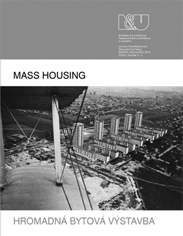FROM ‘GRAND ENSEMBLE’ TO ARCHITECTURAL HERITAGE, FROM CONCENTRATION CAMP TO MEMORIAL The mass housing project of the Cité de la Muette in Drancy, near
FROM ‘GRAND ENSEMBLE’ TO ARCHITECTURAL HERITAGE, FROM CONCENTRATION CAMP TO MEMORIAL The mass housing project of the Cité de la Muette in Drancy, near
Author(s): Pieter UyttenhoveSubject(s): Cultural Essay, Political Essay, Societal Essay
Published by: Historický ústav SAV, v. v. i.
Keywords: mass housing; concentration camp; prefabrication; suburb; modern heritage
Summary/Abstract: This article deals with the pre-war Cité de la Muette at Drancy, in the suburbs of Paris, as one of the key harbingers leading to the international post-war phenomenon of mass social housing. It constitutes a reflection on the clash between modern architecture and the responsibilities of history. In several respects, the project of Drancy is emblematic of the heritage of the Modern Movement, demonstrating that mass housing contained, even in its early experiences and development before the Second World War, the seeds of many of the main problems that characterise the post-war period. The historical period from the end of the 1930s until today will be discussed through a number of urgent questions regarding the phenomenon of the “grand ensemble” (the French term for “mass housing development”). After Drancy, architecture should have lost all utopian illusions regarding the ability to improve people’s lives simply by organising space, an ideal the architects must have held when they designed the housing project of La Muette, which was then considered to be a “model town planning operation in the Paris region, conceived by two functionalist architects yearning for modernity”. Building a New Society At the time of construction of La Muette, Eugène Beaudouin and Marcel Lods were achieving rapidly rising fame as modernist architects for their technically bold and socially progressive schemes. At the time when they designed the Cité de la Muette at Drancy, they had built, among other projects, the Cité du Champ-des-Oiseaux at Bagneux, in addition to other large-scale housing schemes. By the time of their separation at the beginning of the Second World War, their achievements included their entry for the competition for a new major exhibition hall organised by the OTUA to promote the use of steel; the open air school at Suresnes; the Festival of Light for the International Decorative Arts Exhibition in 1937; the clubhouse of the Roland Garros aerodrome at Buc; the House of the People at Clichy, and many others. The housing project of La Muette at Drancy is considered to be the first “grand ensemble” in France. The commission was awarded by Henri Sellier, one of the most important socialistpoliticians of his time in France, senator of the Seine départment and minister under Léon Blum; who initiated an important series of garden cities in the suburbs of Paris. The housing project of La Muette was conceived between 1931 and 1934 for the Office Public d'Habitation à Bon Marché de la Seine, one of the biggest social housing bodies of the Paris region, by the young modern architects Eugène Beaudouin and Marcel Lods, and built with the help of the engineer Eugène Mopin. It was also one of the earliest occasions that the builder Jean Prouvé, who designed the metal framework, had collaborated in an architectural project on this scale. The concept is based on the principle of what was termed the “vertical garden city”, proposed by Beaudouin and Lods...
Journal: Architektúra & Urbanizmus
- Issue Year: 46/2012
- Issue No: 3-4
- Page Range: 160 - 179
- Page Count: 20
- Language: English

